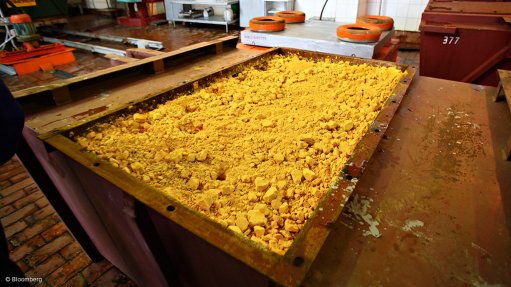
Photo by: Bloomberg
TORONTO (miningweekly.com) – Canadian uranium explorer U3O8 Corp this week reported positive preliminary assessment (PEA) results for its Laguna Salada project, in Argentina’s Chubut province.
The TSX-listed explorer on Tuesday said uranium at Laguna Salada could be produced at an average life-of-mine (LoM) cash cost of $21.62/lb of uranium, net of vanadium by-product credits, for a total capital cost of $134-million, which could be paid back in 2.5 years.
“The PEA achieved our main goal of showing that Laguna Salada’s cash cost would be well within the lower quartile of the uranium industry – an important achievement that bodes well for the deposit’s potential to ride out cyclical lows in the resource sector,” U3O8 Corp president and CEO Dr Richard Spencer said.
Over the surface mine’s projected ten-year mine life, cash cost were pegged at $22/lb, making the project potentially competitive with low-cost in-situ recovery uranium projects and with high-grade deposits in the Athabasca basin of Saskatchewan, Canada.
Spencer said the project had a short payback period, with an average cash cost of $16/lb of uranium over that period. This was owing to the shallow, flat-lying nature of the Laguna Salada deposit, which allowed the company to start production in the higher-grade zones where profit margins would be the greatest.
According to the PEA’s pretax base case scenario, which used a $60/lb price for uranium, the current initial resource had a net present value at a 7.5% discount rate of $55-million and a pretax internal rate of return (IRR) of 24% and post-tax IRR of 18%.
Laguna Salada would produce yellowcake at an average cash cost of $16.14/lb over the payback period, while the LoM cash cost was $21.62/lb, net of a vanadium credit, and included a 3% net smelter royalty payable to the State.
“Therefore, the project will have a healthy operating margin even at current uranium prices and is favourably leveraged to a strengthening uranium price,” Spencer stated.
The mine would start production at a rate of 1.3-million pounds of uranium in the first year, while the average yearly output over the LoM would be 640 000 lb/y. The mine would also, on average, produce 960 000 lb/y of vanadium over the LoM.
Laguna Salada has a compliant indicated resource of 47.3-million tonnes, grading 60 parts per million (ppm) uranium and 550 ppm vanadium oxide, for 6.3-million pounds of uranium and 57.1-million pounds of vanadium.
In the inferred category, the project has 20.8-million tonnes, grading 85 ppm uranium and 590 ppm vanadium oxide, for 3.8-million pounds of uranium and 26.9-million pounds of vanadium.
Spencer said increasing the resource size would significantly enhance the project’s economics – therefore, the company’s immediate goal was now to expand the current resource into U3O8 Corps' adjoining La Susana area.
“The Laguna Salada PEA marks a key milestone towards positioning U3O8 Corp among the few companies that could be in production heading into a sustained and growing global uranium supply deficit forecast to start in 2019.
“The study shows that Laguna Salada is well placed as one of the most advanced uranium projects in Argentina that could satisfy the immediate needs of the country’s current nuclear reactors that presently rely on imported uranium for fuel. Argentina’s third reactor has just come on-stream and deals were signed in the last month related to building a fourth reactor, with talks under way on a fifth,” Spencer noted.
He added that with district-scale uranium potential evident in the Laguna Salada region, the company could serve Argentina’s growing nuclear fleet as well as export to other utilities, supported by the large number of nuclear cooperation agreements signed by Argentina.